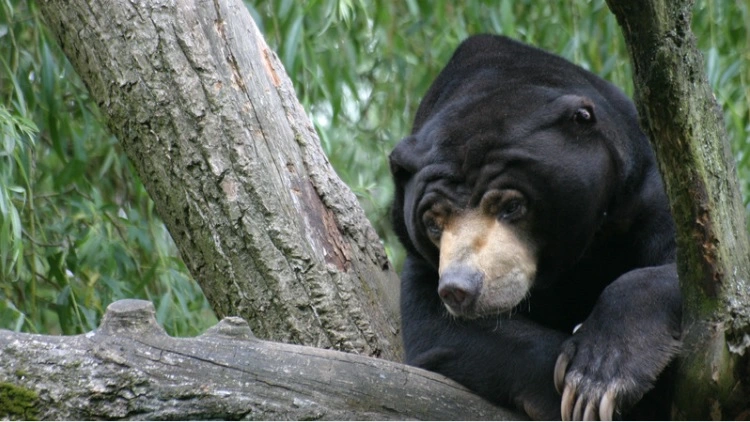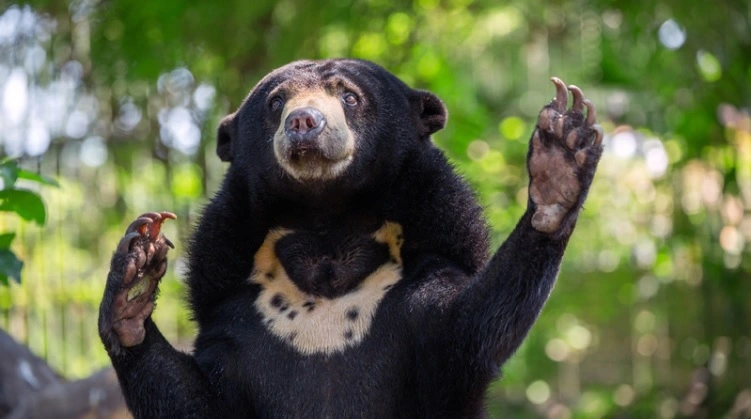The Kinkajou, commonly referred to as the Honey Bear, is a captivating mammal found in the tropical rainforests of Central and South America. With its round face, big eyes, and furry coat, this little creature exudes cuteness from every angle. Despite its bear-like appearance, the Kinkajou is actually related to raccoons. Known for their nocturnal habits, these arboreal animals spend most of their time high up in the trees. Their prehensile tails help them navigate through the dense canopy with ease as they search for their favorite treat: sweet honey and fruits. These agile climbers move gracefully among branches using their sharp claws.
The Honey Bear’s social life revolves around small family groups or solitary living depending on individual preferences. They communicate through soft vocalizations and scent marking to establish territories and attract mates. Stay tuned as we uncover more intriguing details about this charming rainforest dweller!
Overview of Kinkajou
Native to the tropical rainforests of Central and South America, the Kinkajou is a fascinating mammal known for its cute appearance and unique behaviors. Sometimes referred to as the “honey bear,” this nocturnal creature belongs to the raccoon family but looks more like a mix between a monkey and a bear. With large eyes, round ears, and a long prehensile tail, they are agile climbers that spend most of their time in trees.
Kinkajous have soft golden-brown fur that helps them blend into the canopy where they live. Their diet mainly consists of fruit, particularly nectar from flowers which gives them their nickname “honey bear.” Despite being solitary animals by nature, these social creatures occasionally interact with others during mating or when sharing food sources. Their forest habitat provides ample opportunities for exploration and foraging at night when they are most active. Kinkajous play an essential role in seed dispersal within their ecosystem due to their feeding habits, helping maintain biodiversity in the rainforest.
Behavior and Social Life Of Honey Bear
Kinkajous, also known as honey bears, are fascinating creatures with intriguing behavior and social lives. These adorable mammals are primarily nocturnal, spending their days resting in tree hollows or dense foliage. As the sun sets, they become active, moving gracefully through the trees in search of food like fruit and insects. While kinkajous are mostly solitary animals, they do form small family groups consisting of a mother and her offspring. They communicate through various vocalizations such as chatters, whistles, and screeches to maintain contact with one another within their dense forest habitat.
Social interactions among kinkajous often revolve around breeding activities or territorial disputes. Males may compete for access to females during mating season while females fiercely protect their young from potential threats in the wild. Observing these charming honey bears navigate their social interactions provides a glimpse into the intricate dynamics of tropical rainforest ecosystems where every creature plays a vital role in maintaining balance and harmony.

Reproduction and Family Dynamics
Kinkajous, also known as honey bears, have fascinating reproduction and family dynamics. These tropical rainforest mammals typically mate once a year during the rainy season when food is abundant. After a gestation period of around 100-118 days, female kinkajous give birth to one offspring, although twins are not uncommon.
The newborn kinkajou is blind and completely dependent on its mother for care and nourishment. The mother provides constant attention to her young, nursing them until they are old enough to start consuming solid foods like fruits and insects. This close bond between the mother and her offspring helps ensure the survival of the species in their challenging rainforest habitat. As the baby kinkajou grows older, it gradually becomes more independent but may stay with its mother for up to a year before venturing out on its own. During this time, young kinkajous learn essential skills from their mothers such as foraging techniques and how to navigate through the dense forest canopy.
Habitat and Diet
The Kinkajou, also known as the honey bear, thrives in the lush canopy of tropical rainforests. These adorable creatures are primarily nocturnal, spending their days curled up in tree hollows or nestled in dense foliage. Their large eyes help them navigate through dimly lit forest environments. Their diet consists mainly of fruits like figs and mangos, nectar from flowers, and even small insects. With their long tongues adapted to extracting nectar from deep within blossoms, they play a crucial role in pollination within their habitat.
Kinkajous are agile climbers due to their sharp claws and prehensile tails that serve as an extra limb for balance while moving amongst branches. This enables them to access hard-to-reach food sources high up in trees with ease. Despite facing threats such as deforestation and illegal pet trade, conservation efforts aim to protect these unique mammals and preserve their natural habitat for future generations to enjoy witnessing these enchanting honey bears thrive harmoniously in the tropical rainforest ecosystem.
Conservation Efforts
Conservation efforts for the honey bear, a tropical rainforest mammal, are crucial to ensure their survival in the wild. Due to deforestation and habitat loss, these adorable creatures face significant threats to their existence. Organizations and wildlife advocates worldwide are working tirelessly to protect kinkajous and their habitats. Efforts include establishing protected areas where these animals can thrive undisturbed by human activities. Conservationists also focus on raising awareness about the importance of preserving biodiversity in tropical rainforests like those where honey bears reside. By educating local communities and promoting sustainable practices, we can help safeguard these unique mammals for future generations.
Supporting research initiatives is another vital aspect of conservation work. Studying kinkajou behavior and population trends enables scientists to develop effective strategies for their protection. Collaborative conservation projects involving governments, NGOs, and local stakeholders play a key role in ensuring the long-term survival of this enchanting species.
Fascinating Facts and Fun Trivia
If you find yourself fascinated by the mysterious and charming honey bear, also known as the kinkajou, here are some intriguing facts and fun trivia to deepen your admiration for this tropical rainforest mammal. Did you know that kinkajous have a prehensile tail? This unique adaptation allows them to easily navigate through the dense canopies of their rainforest homes. They use it like an extra limb to grasp branches or even hang upside down while feeding on fruits and nectar.
In addition to their agile tails, these adorable creatures have long tongues that they use to extract insects from tree crevices or sip nectar from flowers. Their tongues can be up to 5 inches long, which aids them in accessing hard-to-reach treats high above on tree branches. Despite their cute appearance, kinkajous are skilled climbers and can traverse treetops with ease. They move swiftly through the canopy using their sharp claws for grip and balance. These acrobatic abilities help them avoid predators and search for food efficiently in their lush habitats.
Furthermore, kinkajous are nocturnal animals, meaning they are most active during the night. This behavior helps them evade diurnal predators while taking advantage of fewer competitors for resources in the darkness. Their keen senses of smell and hearing aid them in navigating through low-light conditions as they hunt for food under cover of darkness. These fascinating facts about honey bears showcase just how remarkable and adaptive these creatures truly are in their tropical rainforest ecosystems. Whether it’s their unique physical features or behavioral traits, there’s always something new to learn about these captivating mammals roaming amidst the vibrant foliage of the rainforest canopy.
Interaction with Humans
Humans have a complex relationship with honey bears, also known as kinkajous. These cute creatures are sometimes kept as exotic pets due to their charming appearance and playful nature. However, owning a honey bear can be challenging as they require specialized care and can become aggressive if not properly trained.
Unfortunately, the demand for these animals in the illegal pet trade threatens wild populations. Conservationists work tirelessly to educate the public about the importance of protecting these unique mammals in their natural habitats. In some regions, indigenous communities have traditional beliefs associated with honey bears, leading to conflicts between human activities and wildlife conservation efforts. It is crucial to find a balance that respects both cultural practices and biodiversity conservation. Fostering respect for these fascinating creatures among humans is essential for ensuring their survival in the face of increasing threats from deforestation, habitat loss, and illegal trafficking.
Conclusion
The Kinkajou, also known as the honey bear, is truly a fascinating tropical rainforest mammal. Its unique characteristics, adorable appearance, and interesting behaviors make it a captivating species to learn about and admire. From its arboreal lifestyle to its sweet tooth for nectar and fruits, the Kinkajou showcases how diverse and remarkable wildlife can be in these lush environments.
As we continue to appreciate and study these charming creatures, it becomes evident that preserving their habitat is crucial for their survival. Through conservation efforts aimed at protecting tropical rainforests and promoting sustainable practices, we can help ensure that future generations will have the opportunity to marvel at the beauty of the honey bear in its natural home. So next time you find yourself exploring a tropical rainforest or learning about exotic animals from afar, remember the delightful Kinkajou – an enchanting symbol of biodiversity thriving in one of Earth’s most precious ecosystems.









